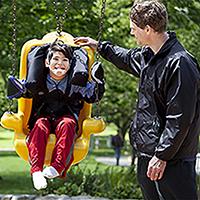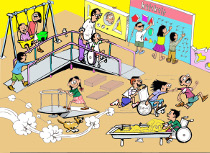
Every child, however abled, has the right to play, says Kavitha Krishnamoorthy. But India’s playgrounds are often not friendly for kids with disabilities. What about your local playground? You can change that with a little effort.
A play space in a public park. Full of young children swinging high, sliding, twirling on the merry-go-round, running, skipping, jumping, climbing. Resounding with joyous laughter, excitement, fear. Some fights, pushing and pulling…..
What’s missing in this picture-perfect scenario?
Have we ever wondered about a group of children who seem conspicuous by their absence? Children who are not able to access this play space simply because it does not meet their needs?
Have we ever wondered why we do not see a child with a disability in a public park?
Have we ever wondered how we as a society, a community, can be so blind to their requirements?
And that this is really unfair and unjust.
Inaccessible play spaces - a violation of the child’s right to play
Children with disabilities are unable to play along with their typically growing peers in any play space simply because these spaces have not been designed to welcome them, they are not universally accessible. They do not have ramps to allow children who use wheelchairs to easily come in, they do not have signages in Braille that can help children who read using Braille navigate the play space, they do not have quiet corners where children, such as those with autism can retreat, if the overall stimulation becomes too much for them to handle.
And most important of all, even if all of the above existed, if the play equipments are not designed to cater to the unique needs of children with disabilities, they would only sit on the sidelines and not be able to actively participate in play.
Such spaces are nothing but a clear violation of the right of every child with a disability to be able to play, in spaces that all other children play.
Making a play space inclusive
Enabling physical access
What does it take to make a play space physically accessible? Does it cost a lot of money that in a resource-scarce country we find difficult to garner?
In the experience of Kilikili, a parents-professionals-volunteers group working over the last nine years to develop inclusive play spaces in India, it is never about lack of money. (We have developed play spaces with existing budgets of Municipal Corporations.) It is really about a mind-set, a perspective. A worldview that sees enabling play for children with disabilities as a non-negotiable, as a given. Once we make that shift, we start seeing ways in which this can be enabled.
Simple modifications. Nothing that’s rocket science.
- A swing whose seat is designed like a big diaper which provides complete safety to a child with little upper body support.
- Another swing designed like a bench where a caregiver or a friend can sit along with a child who needs support.
- A sand table – a sand pit at table height – that sits alongside a ground level sand pit - enabling all children to build castles in the sand, together.
- A basketball with two hoops, one at a lower height to enable children on wheelchairs and younger, typically growing children to play.
- A quiet corner with sand or water for calming children.
- A tyre tunnel where children can have fun while learning to crawl.
- A sensory wall or a sensory track with a variety of textures that children can feel.
- Ramps, pathways, relevant signages.
Enabling social access
Our experience has also shown us that physical access is a necessary, but not a sufficient condition to ensure that children with and without disabilities can play together.
Just because an inclusive space exists, we cannot assume that children with disabilities will automatically start using it. They need the support of parents, schools and other caregivers to bring them to the play space and help them play. Parents, in turn, need the support and acceptance of the larger community to help them feel at ease in bringing their children to the play space.
This requires parents as well as schools and institutions that serve children, to put aside their own inhibitions and not worry too much about how their child will ‘behave’!
It also requires greater sensitivity and acceptance from other adults and children who use the play space, to find ways to engage with the child with a disability. This sensitivity and acceptance can actually be built in the context of an inclusive play space.
In fact, it’s a chicken and egg situation. Since typically growing children have so little opportunity to interact with children with disabilities, they are uncomfortable and simply do not know how to interact. But provide them the opportunity and over time, we find that they do find ways to play together.
And then, a final question - why do we need to do this at all?
I believe we need to ensure inclusivity through play because
- Every child has a right to play, nothing and nobody can take this away from a child
- We, as a community, have a responsibility to ensure that every child can claim her/his right to play
- When we enable all children to play together, we are taking baby steps towards a creation of a community, a society, a world where everyone is respected for who they are, where diversity is celebrated, where empathy and acceptance are not buzz words or an aspiration but very much the way we live life.
Is this too much to ask?
PatientsEngage Update in Jan 2017:
Now Kilikili has created a policy guidelines and technical manual to help you create inclusive play spaces. Kilikili has kindly given us a copy of the e-book that you can download for free from link below.
Inclusive Play Design Manual Booklet
Kavitha Krishnamoorthy is the parent of a child on the autism spectrum and the founder of Kilikili, an organisation working towards making Inclusive Play a reality in India. For more information, please see www.kilikili.org







